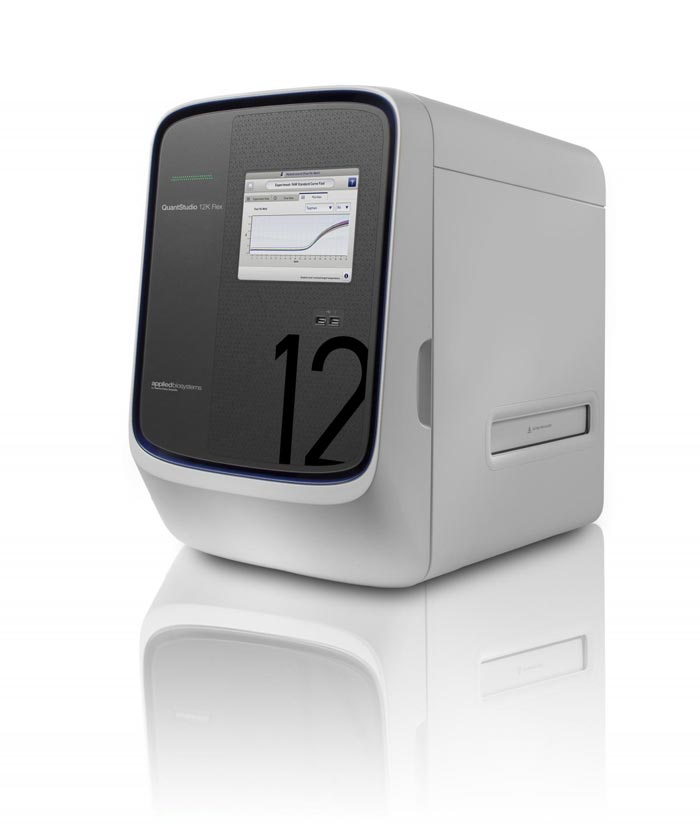New technology enables effective simultaneous testing for multiple blood-borne pathogens

The QuantStudio 12 is the Thermo Fisher Scientific instrument that processes the OpenArray plates that carry the PCR reagents and the nucleic acid samples accomplishing the multiplex pathogen detection. Note: This OpenArray Platform is a research use only device and is not cleared or approved for clinical use. Credit: Thermo Fisher Scientific
The emergence of new pathogens like West Nile Virus, Ebola, Dengue, and Zika, threaten human health on a global scale. Identification of these pathogens requires a rapid response from industry to develop new tests and the FDA to assess test safety and efficacy. A report in The Journal of Molecular Diagnostics evaluates the new OpenArray system that offers simultaneous detection of multiple viruses, bacteria, and protozoan pathogens in human blood samples. Investigators determined that this system is a promising tool for flexible, fast, and accurate blood screening.
Some highly virulent pathogens may have a low prevalence rate and/or be restricted seasonally or geographically. However, the impact of transfusion-transmitted infection of such agents can have fatal consequences, particularly in highly vulnerable populations such as newborns, the elderly, or immunocompromised individuals. The cost effectiveness of a multiple agent test means that more testing could be done, resulting in safer blood.
“All blood for transfusion must be tested for infectious agents. The increasing number of agents that may infect blood and the recognition that some of them only pose a risk in certain areas or certain times means that new methods to streamline blood testing must be developed. The major feature of our OpenArray device, the ability to test for multiple infectious agents at the same time, could be an answer to that need,” explained Robert Duncan, PhD, an investigator with the Food and Drug Administration's Center for Biologics Evaluation and Research, Silver Spring, MD.
Many “singleplex” tests approved by the FDA are available to measure one specific pathogen. Less commonly available are “multiplex” systems that can detect multiple pathogens. The OpenArray platform (Thermo Fisher Scientific) simultaneously tested 17 viral strains in human plasma samples (e.g., HIV-1, HIV-2, Dengue, influenza, Chikungunya) and 13 types of bacteria (e.g., Escherichia coli, Staphylococcus aureas) and protozoa (e.g., Leishmania donovani, L. infantum, Babesia microti) in human blood samples. The individual tests use real-time PCR, which are spatially separated on the OpenArray device allowing a high level of multiplexing.
“New multiplex PCR-based diagnostic technologies aimed at faster and more accurate pathogen identification are increasingly used for detection of respiratory or gastrointestinal pathogens, yet testing for a multitude of pathogens directly in the blood is still at the research stage. This study demonstrated that new technologies can enable early and accurate detection of pathogens directly in blood samples. The engagement and coordination of a number of stakeholders, including regulatory, clinical practitioner, and the diagnostics industry, are necessary for implementation of such disruptive technologies for patient care,” added Elena Grigorenko, PhD, Vice President of Research and Development with Diatherix Laboratories, Eurofins Clinical Diagnostics Division at Huntsville, AL.
To design this device, the first step required choosing regions on each of the pathogen genomes to target and short pieces of DNA to accomplish that targeting. These short pieces, called primers and probes, which achieve the PCR, were loaded into the OpenArray device. The next critical step was laboratory growth of the 30 pathogens and mixing each one of them with normal volunteers' whole blood or plasma to mimic the blood from an infected individual. Once performance of the device was adjusted to maximum ability to detect these infectious agents in the mock clinical samples, it was tested with 92 donor samples obtained from a blood donor testing center with known pathogen content, as determined by FDA-licensed tests. Ninety-five percent of virus-positive samples were correctly identified.
“We need the next generation of superior performance tests that will detect an increasing number of transfusion-transmittable agents in multiplex format with high sensitivity and specificity, robustness, and adaptability to accomplish detection of new pathogens and maintain the safety of blood products,” commented Dr. Duncan. “Our goal in this research is to provide a proof of concept that will stimulate device developers to advance new technology for multiple assay testing devices into clinical use.”
“In support of this initiative, Phillip Williamson, PhD, VP of Operations and Scientific Affairs, said, “As the largest independent blood donor testing organization in the U.S., Creative Testing Solutions welcomes the opportunity to work with the FDA and others on new research initiatives and clinical trials that will ideally improve blood donor testing and the safety of the U.S. blood supply.”
This OpenArray Platform is a research use only device and is not cleared or approved for clinical use.
Media Contact
All latest news from the category: Medical Engineering
The development of medical equipment, products and technical procedures is characterized by high research and development costs in a variety of fields related to the study of human medicine.
innovations-report provides informative and stimulating reports and articles on topics ranging from imaging processes, cell and tissue techniques, optical techniques, implants, orthopedic aids, clinical and medical office equipment, dialysis systems and x-ray/radiation monitoring devices to endoscopy, ultrasound, surgical techniques, and dental materials.
Newest articles

First-of-its-kind study uses remote sensing to monitor plastic debris in rivers and lakes
Remote sensing creates a cost-effective solution to monitoring plastic pollution. A first-of-its-kind study from researchers at the University of Minnesota Twin Cities shows how remote sensing can help monitor and…

Laser-based artificial neuron mimics nerve cell functions at lightning speed
With a processing speed a billion times faster than nature, chip-based laser neuron could help advance AI tasks such as pattern recognition and sequence prediction. Researchers have developed a laser-based…

Optimising the processing of plastic waste
Just one look in the yellow bin reveals a colourful jumble of different types of plastic. However, the purer and more uniform plastic waste is, the easier it is to…



